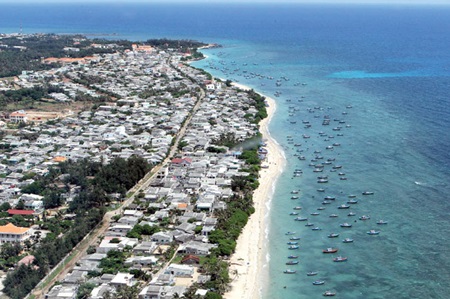Deputy Minister of Natural Resources and Environment, Chu Pham Ngoc Hien, said the conference was a chance for ministries and provinces to contribute ideas for an action plan needed to realise the 2015-2020 strategy.
It stresses socio-economic development that adheres to the laws of nature by being environmentally friendly, and which takes into considerations ecological conditions specific to each region as well as its capacity to adapt to climate change.
It requires clear delineation of responsibilities of each ministry, sector, industry and locality, and facilitates the involvement of communities, social organisations as well as other countries.
The strategy calls for the development and institutionalization of co-ordination mechanisms for local authorities and state agencies in managing coastal areas.
Coastal areas are defined in this strategy as consisting of sea waters six nautical miles away from the shore as well as mainland communes bordering the sea.
It calls for regulations on demarcating sea boundaries for coastal provinces in order to "identify their powers and responsibilities" and to "minimise conflicts of interest" among industries and provinces in exploiting marine resources, in the context of many State agencies having charge of some coastal areas.
The strategy also mentions the need to build a database and an integrated information management system to manage coastal areas.
To aid effective management and use of coastal natural resources and spaces, all plans related to coastal areas, including socio-economic development plans formulated by coastal provinces, will have to be based on the national strategy.
Good practices
The strategy seeks to promote good practices, including community-based management of natural resources, habitats and eco-systems in marine and coastal areas. This aims at enhancing coastal dwellers' sense of responsibility and right to benefit from coastal natural resources as well as creating sustainable livelihoods.
The strategy also highlights the need for implementing programmes and plans to protect, preserve and restore coastal eco-systems, habitats, fauna and flora as well as other values that have disappeared or are on the brink of disappearing because of human and natural impacts. These programmes and plans should factor in climate change and rising sea levels.
Preventing and limiting pollution, mitigating damage inflicted by natural calamities, training people for effective coastal management at central and provincial levels are also covered by the strategy.
Vu Sy Tuan, head of the Viet Nam Administration of Seas and Islands, told the conference that the strategy would deploy the new integrated management method incorporated in the Law on Natural Resources and the Environment of Seas and Islands that was recently approved by the National Assembly.
Dr. Christian Henckes, head of the German Agency for International Cooperation (GIZ)'s integrated coastal management programme, said that the German government would continue supporting Viet Nam in managing its natural resources and protecting the coastal environment through increased co-operation in building sea wave breakers, preserving alluvial grounds and restoring coastal mangrove forests.
Germany will also help Viet Nam access international financial resources for projects on integrated management in combination with climate change responses, he said.
Source: Vietnam Net Bridge | 11 July 2015














